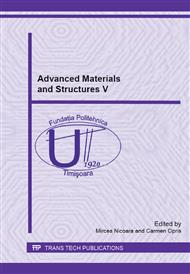[1]
A. Azari, S. Nikzad, The evolution of rapid prototyping in dentistry: a review, Rapid Prototyping J. (2009); 15: 216-225.
DOI: 10.1108/13552540910961946
Google Scholar
[2]
T.M. Barker, W.J.S. Earwaker, N. Frost, G. Wakeley, Integration of 3D medical imaging and rapid prototyping to create stereolithgraphic models, Australas Phys Eng Sci Med (1993); 16(2): 79-85.
Google Scholar
[3]
R. Schenker, D.J. Beer, W.B. Preez, M.E. Thomas, P.W. Richter, Novel combination of reverse engineering and rapid prototyping in medicine, South African J Sci (1999); 95: 327-328.
Google Scholar
[4]
P.D. Hilton, P.F. Jacobs M. Dekker, Rapid tooling: technologies and industrial application, New York, (2000).
Google Scholar
[5]
P.F. Jacobs, Rapid prototyping & manufacturing: fundamentals of stereolithography, Society of Manufacturing Engineers (1992), Dearborn, MI.
Google Scholar
[6]
O. Eraslan, M. Sevimay, A. Usumez, G. Eskitascioglu, Effects of cantilever design and material on stress distribution in fixed partial dentures - a finite element analysis. J Oral Rehabil (2005); 32: 273-8.
DOI: 10.1111/j.1365-2842.2004.01429.x
Google Scholar
[7]
A.R.M. Correia, J.C.S. Fernandez, J.C.R. Campos, M.A.P. Vaz, N.V.M. Ramos, Stress analysis of cantilever-fixed partial denture connector design using the finite element method. Rev. odonto ciênc. (2009); 24(4): 420-425.
Google Scholar
[8]
R. Dornhofer, G.V. Arnetzl, M. Koller, G. Arnetzl, Comparizon of the static loading capacity of all-ceramic bridge frameworks in posterior teeth using the hard core materials. Intl J Comput Dent (2007); 10: 315-28.
Google Scholar
[9]
Oh WS, Anusavice KJ. Effect of connector design on the fracture resistance of all-ceramic fixed partial dentures. J Prosthet Dent (2002); 87: 536-42.
DOI: 10.1067/mpr.2002.123850
Google Scholar
[10]
M. Tsumita, Y. Kokubo, P. Vult von Steyern, S. Fukushima, Effect of framework shape on the fracture strength of implant-supported all-ceramic fixed partial dentures in the molar region. J Prosthodont (2008); 17: 274-85.
DOI: 10.1111/j.1532-849x.2007.00287.x
Google Scholar
[11]
H. Fischer, M. Weber, R. Marx, Lifetime prediction of all-ceramic bridges by computational methods. J Dent Res (2003); 82: 238-42.
DOI: 10.1177/154405910308200317
Google Scholar
[12]
S.A. Romeed, S.L. Fok, N.H. Wilson, Finite element analysis of fixed partial denture replacement. J Oral Rehabil (2004); 31: 1208-17.
DOI: 10.1111/j.1365-2842.2004.01354.x
Google Scholar
[13]
A. Colin, J.Y. Boire, A novel tool for rapid prototyping and development of simple 3D medical image processing applications on PCs, Comput Methods Programs Biomed (1997); 53(2): 87-92.
DOI: 10.1016/s0169-2607(97)01807-5
Google Scholar
[14]
C.K. Chua, S.M. Chou, S.C. Lin, K.H. Eu, K.F. Lew, Biomedical applications of rapid prototyping systems, Automedica (1998); 17(1): 29–40.
Google Scholar


